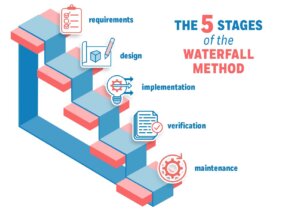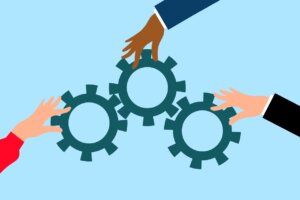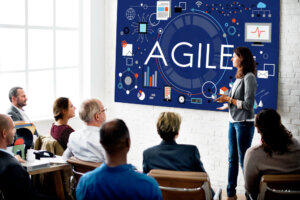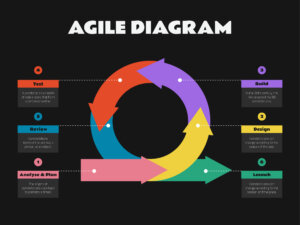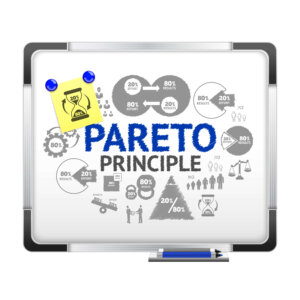Every project comes with its unique challenges. But there’s one challenge that accompanies every project you’ll work on: deciding which project management methodology to choose. The waterfall vs agile question is the most frequent one you’ll come across in this discourse.
As important as it is to answer, this question might have you bogged down even before you make any progress on the project itself. To make things easier, we’ve thoroughly researched the two methodologies to bring you this waterfall vs agile comparison. Continue reading to find out which project management methodology is the better choice for your project.
The waterfall methodology is the older and more traditional project management system. It’s a linear model that divides your project into five to seven strictly sequential phases. In waterfall, you must fully complete a phase before you move on to the next.
This linear project development method isn’t flexible and won’t give you a lot of space to change course after you’ve started working on it. It also requires extensive documentation and planning upfront to design and implement a solution.
- Easy to manage
- Gives an accurate estimate of cost and time
- Lets you create a repeatable process
- Inflexible
- Carries high risk for larger projects
- Requires a lot of time for documentation and planning
The agile project management methodology is more flexible as it was designed to replace the waterfall method’s rigid structure. It’s a cyclic process that divides your project into sprints.
Instead of planning everything upfront, agile management follows a more adaptive and collaborative approach. It’s further divided into seven different frameworks that are suitable for different kinds of projects.
- Greater flexibility
- Faster development
- Greater involvement of clients
- Costs are higher than other methodologies
- Project can go off-track as requirements aren’t clearly defined
- High customer involvement leads to delays
Waterfall vs Agile Project Management – Comparative Overview
Waterfall and agile are two of the most commonly used models in the history of project management. We can’t single out a clear winner because both have their pros and cons and suit different kinds of projects.
Note that waterfall or agile management techniques are not the only two options. You can also find a middle ground by going for a waterfall-agile hybrid approach. You can keep the features you like from both methods to develop your own hybrid.
A PMI report suggests that on average, nearly 44% of projects go for the waterfall methodology, 30% use agile, while 23% use hybrid models.
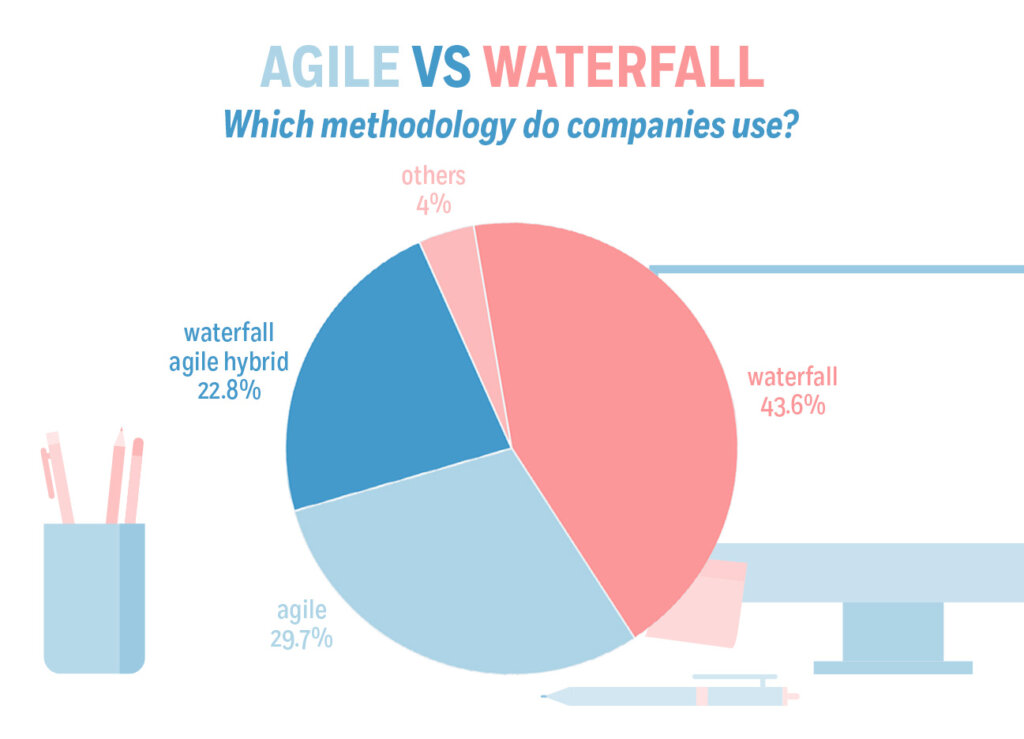
You need to familiarize yourself with both management methods to make an accurate comparison and reach the right decision for your project. Here’s a summary for you to compare the two management methods with ease:
Agile vs Waterfall Comparison Chart
Waterfall
Agile
Project Scope
Works well when the scope is clearly defined before the project starts.
Works well even if the scope is not well-defined. Making changes to the project after it starts is easier but may incur expenses.
Timeline
Has a fixed timeline. Better for short-term projects.
Has no fixed timeline. Better for longer or continuous projects that require greater innovation.
Budget
Has a fixed budget. Involves less risk since the budget is finalized upfront.
Has a flexible budget. Increases funding efficiency.
Flexibility
Not flexible. Waterfall projects are fully planned out in the initial stages and different phases cannot overlap.
Very flexible. Allows for innovation and collaboration and makes it easy to change project courses.
Customer Involvement
Minimal customer involvement.
Involves collaboration with customers in every phase.
Team
Good for larger teams with less coordination.
Good for smaller, dedicated teams with high coordination.
Risk
Carries more risk for large projects as the final product isn’t ready for testing until the final stages.
Carries less risk because the product is frequently tested throughout the project.
Waterfall Project Management Methodology
The waterfall project management methodology is based on three basic principles. A sequential structure, minimal customer involvement, and robust documentation of every phase it entails.
Being sequential in nature means all stages are mapped out chronologically and you must follow the same pattern. Going back to a previous phase or changing the direction of the project is only possible if you start all over again.
Communication with clients takes place only in the requirement-gathering phase. Little to no communication takes place in the development stages. Extensive documentation means all steps and specifications are documented in detail in the waterfall model.
5 Stages of the Waterfall Model
The waterfall model divides your project into five phases. The number of phases can be more for complicated projects but it basically remains a five-step process.
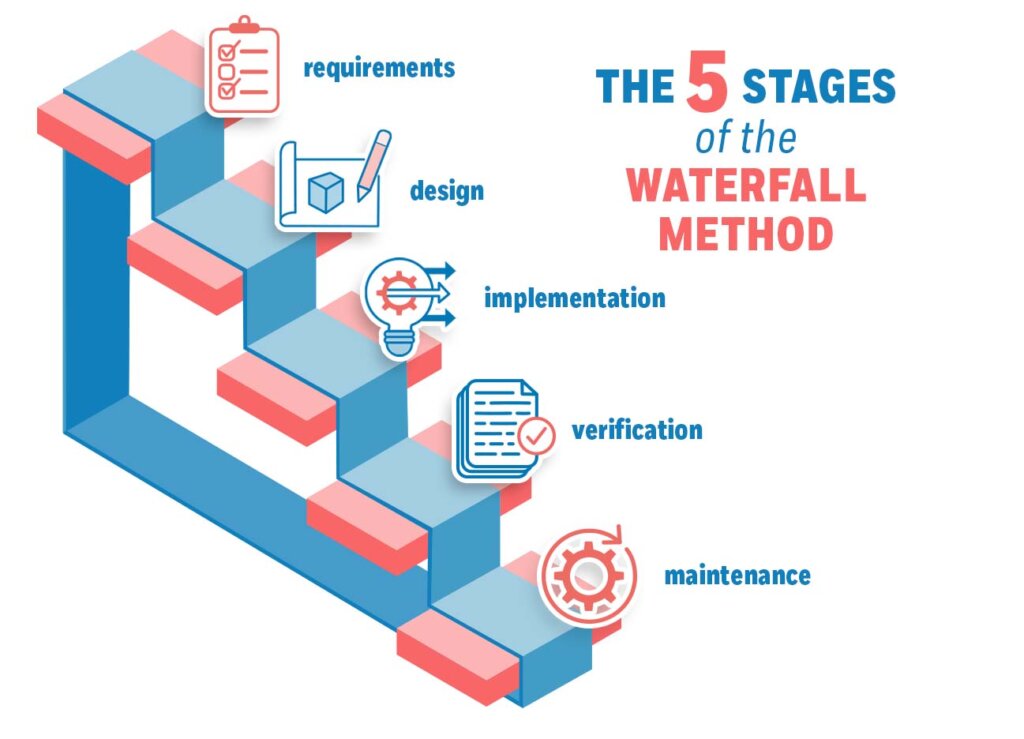
- Documenting requirements: In the first phase, you gather and document all the information you can from the client. This includes their requirements, budget, timeline, and any other details that are essential to the completion of the project.
- Design: The design phase is where you prepare the logical and physical design of the deliverable. This includes specifying each step of the development process including the software and hardware tools you’d be using.
- Implementation: The implementation stage is where you prepare the actual product. It doesn’t take a lot of time since you have everything planned out already.
- Verification: Once you’ve prepared the product you’re working on, you run tests on it during the verification or testing phase. Minor bugs are fixed and the waterfall continues to the last stage. But in case of major faults, you have to return to stage one.
- Maintenance: After you’ve released the product to the customer, some issues may arise when they use it practically. This is when your maintenance team works on the product, debugging it from time to time.
Who Should Use the Waterfall Model?
Since this project management method lacks the agility and flexibility many fast-paced projects require, it’s clearly not the choice for everyone. However, the waterfall model is a good choice for you in three scenarios.
- You have clearly defined requirements: If you or your client knows exactly what they want as the outcome, using waterfall is a straightforward way to manage the project without unnecessary complications.
- You have an inflexible schedule: Rigidity meets rigidity. If you need to stick to an inflexible timeline or tasks involved in a project, waterfall’s highly structured nature suits you. This is especially true for construction and manufacturing projects.
- You have time for planning: Requirements and design are two of the most time-consuming phases in the model. If you have enough time to plan out your project thoroughly, this linear methodology ensures you invest your resources correctly.
Agile Project Management Methodology
As the name suggests, agile project management is a more flexible and adaptive approach. It’s a modern model that works best for fast-paced projects where you want to keep space for innovation and improvisation.
Agile management is based on seven key principles:
- Adaptability: Collaborate with customers and accept changing requirements throughout the development process.
- Lean development: Agile development focuses on keeping the final product as simple as possible. You want to achieve the same outcome with the least complications.
- Customer involvement: Agile teams include developers, investors, end-users, and other stakeholders in all stages.
- Time: This methodology gets most work done in the least amount of time. You will break down your timeline into small time-boxed sprints.
- Teamwork: Agile development focuses on teamwork more than anything else. Give dedicated team members the resources and support they need to deliver quality work.
- Build and test: Deliver a working product frequently during the development phases.
- Sustainability: Instead of pushing for faster work, develop a sustainable pace where you can deliver a quality product.
6 Stages of the Agile Model
- Concept: In the first stage, the client informs you about their requirements and the key features they expect from the product. You try to document all specifications even though it’s not a necessity for agile development.
- Inception: This is where you assemble your team and tools. This phase involves brainstorming potential solutions before selecting one for the next stage.
- Iteration: Iteration is the longest phase where you start off by developing the general framework. As you proceed, iterations or sprints move on to improve the product and develop additional features.
- Release: The name suggests otherwise, but this stage first involves quality assurance. Once you’ve thoroughly tested the deliverable for all features and functionalities, the final iteration can be actually released for customers.
- Maintenance: This stage begins when clients identify bugs or request updates and improvements to the product.
- Retirement: In Agile management, the retirement stage starts when the product falls out of use or needs to be replaced. Here you start ‘end-of-life’ activities which include withdrawing all support and letting users know that the product is no longer available.

Who Should Use the Agile Model?
Using agile makes sense when your project is based on complex deliverables, gradual progress, and consists of shorter and overlapping timelines. If you require better communication between cross-functional teams to deliver the product, agile is the way to go. Here are some additional scenarios when agile development is the better choice:
- You have ambiguous requirements: Go for agile management if you or your client haven’t defined project requirements fully but want to start right away, agile management gives you the opportunity to kick things off and correct course along the way.
- You need to deliver quickly: If you’re on a short timeline and need to get the final product ready quickly, agile is a better choice. This way, you won’t have to spend a lot of time on planning and can finish the project earlier.
- You work in an industry that changes quickly: Rapidly innovating industries need agility in their project management process. The agile model lets you adapt quickly so you can stay ahead of the competition.
Agile vs Waterfall: Which Project Management Software to Use?
Choosing the right project management methodology is a challenge. But choosing the right project management software is another challenge in itself. Regardless of the method they employ, the most successful teams utilize advanced software for their project management needs.
Here are some of the best project management software for both waterfall and agile models.
Wrike is one of the best project management tools out on the market. It works with both waterfall and agile methodologies as it offers Gantt charts, Kanban boards, and a range of other useful features. Read an in-depth review on Wrike to find more about it.
Wrike offers a high degree of customizability and fits into all sizes and types of businesses. It may be the costlier option, but the functionality is worth the price tag.
Asana is a top project management software for its ease of use and focus on productivity and collaboration. Its features might suggest that it’s better suited for agile projects but a considerable proportion of its users utilize it for waterfall projects. Asana is one of the more affordable options that offer a wide range of features and potential use cases. Read our comprehensive review on Asana.
monday.com is an award-winning project management platform that helps you efficiently plan and execute complex projects. It’s easy to use and flexible with onboarding new teams and team members. It can work
With a variety of productivity features such as time-tracking, an integrated kanban board, automated notifications, workflow automation, dependencies, multiple views, and calendar integration, teams can achieve better and faster results for every project milestone. Read the monday.com review to find out more about its features and pricing.
Frequently Asked Questions (FAQs) for Waterfall Vs Agile
Bottom Line on Waterfall vs Agile Methodologies
In the end it all boils down to you and your project’s needs. The waterfall focuses on upfront documentation and planning. This means you spend most of your time in the first two planning phases. Although this delays the project, it makes sure you invest your resources with minimum wastage.
On the other hand, agile is the more modern approach. It’s faster, cheaper, and flexible which gives it the edge over waterfall. But this also means that you need a highly dedicated team that can communicate and respond to change well. Still, if you think both are viable options for your project and find yourself torn between the two, a hybrid approach may be the answer.
 Sections of this topic
Sections of this topic


